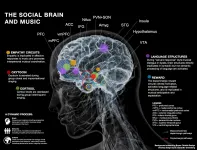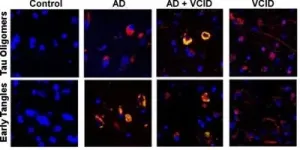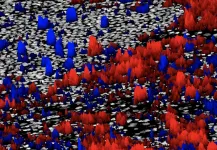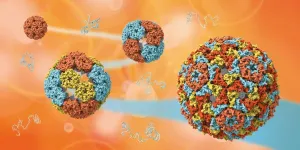(Press-News.org) Music is a tool that has accompanied our evolutionary journey and provided a sense of comfort and social connection for millennia. New research published today in the American Psychologist provides a neuroscientific understanding of the social connection with a new map of the brain when playing music.
A team of social neuroscientists from Bar-Ilan University and the University of Chicago introduced a model of the brain that sheds light on the social functions and brain mechanisms that underlie the musical adaptations used for human connection. The model is unique because it focuses on what happens in the brain when people make music together, rather than when they listen to music individually.
The research was inspired by creative efforts of people around the world to reproduce music-making together while social distancing during the COVID-19 pandemic. This included people singing songs in unison from balcony to balcony, group singing on video conferencing platforms such as Zoom, and live living room concerts by the likes of Yo Yo Ma, Chris Martin from Coldplay, and Norah Jones.
The team fused the latest advances in social neuroscience and the field of music, including evolutionary theory. They synthesized these advances and highlighted five key functions and mechanisms of the brain that contribute to social connection through music.
These are (1) empathy circuits, (2) oxytocin secretion, (3) reward and motivation, including dopamine release, (4) language structures, and (5) cortisol. These five functions and mechanisms involve at least 12 important brain regions and two pathways which are mapped here.
Empathy helps us to tune into how other people are thinking and feeling, and can be improved through interpersonal musical coordination.
Oxytocin is sometimes called the "love hormone" because it contributes to our sense of feeling socially bonded with others. It is secreted when people sing together, even when the singing is improvised.
Dopamine is a neurotransmitter that produces a sense of pleasure and is released during musical anticipation and expectation, and pivotal for our sense of reward and motivation.
Language structures in the brain are involved in back-and-forth musical dialogue (sometimes referred to as "call" and "response").
Cortisol is a hormone that contributes to stress, but it is decreased in the brain when people sing together and when they listen to music together in groups.
The research provides the groundwork for an emerging field called the "social neuroscience of music", which builds on the previously established cognitive neuroscience of music, which largely focuses on music listening.
The authors say a better understanding of the social neuroscience of music can play an important role for helping to improve social bonding around the world, particularly in cultures that are in conflict. They conclude that music is a powerful tool that can bring individuals together, promote empathy and communication, and heal social divisions. They say that a better scientific understanding of how music provides brain-to-brain social connections helps highlight that music isn't mere entertainment, but instead is a core feature of human existence with important social implications.
Dr. David Greenberg, who led the research, is a social neuroscientist, professional musician, and Zuckerman Postdoctoral Scholar at Bar-Ilan University in Israel. He says, "Music connects us to our humanity. Through social neuroscience, we can discover that our sense of social connection isn't just subjective, but that it is rooted in important brain mechanisms. Especially in a time when there is so much social division around the world, we need to find new ways to to bridge cultures in conflict. Music is one of those ways. We hope our research will lead to more grass-roots programs like the West-Eastern Divan Orchestra and the Jerusalem Youth Chorus, which bring people from differing cultures together through music."
Dr. Ilanit Gordon, an Associate Professor at the Department of Psychology and Director of the Social Neuroscience Lab at the Gonda (Goldschmied) Multidisciplinary Brain Research Center at Bar-Ilan, says: "Human sociality is rooted in our biological makeup. Through music we can connect and interact with others, and via the scientific exploration of the neurobiological basis of music, we can further our understanding of major issues in social neuroscience."
Jean Decety, the Irving B. Harris Distinguished Service Professor in Psychology and Psychiatry, and director of Child Neurosuite at the University of Chicago, says, "Music is a fundamental part of our evolution, allowing for unique expressions of social ties. It can strengthen cohesion and mutual trust between people by signaling shared values. It is quite fascinating to understand the neurobiological mechanisms of music."
INFORMATION:
Chestnut Hill, Mass. (6/10/2021) - A British man who rejected the standard of care to treat his brain cancer has lived with the typically fatal glioblastoma tumor growing very slowly after adopting a ketogenic diet, providing a case study that researchers say reflects the benefits of using the body's own metabolism to fight this particularly aggressive cancer instead of chemo and radiation therapy.
Published recently in the journal Frontiers in Nutrition, the report is the first evaluation of the use of ketogenic metabolic therapy (KMT) without chemo or radiation interventions, on a patient diagnosed with IDH1-mutant glioblastoma (GBM). Ketogenic therapy is a non-toxic nutritional approach, viewed as complementary or ...
Just as the governor announced the start of python hunting season in Florida this month, researchers at the University of Central Florida have published a first- of-its-kind study that shows that near-infrared (NIR) spectrum cameras can help hunters more effectively track down these invasive snakes, especially at night.
The snakes, which can reach 26 feet in length and 200 pounds, have invaded the Everglades in Florida -- threatening native species and disrupting the ecosystem. The number of common native species observed in the Everglades since the snakes were first discovered in the 1990s dropped in some species by 90% through 2010, according ...
ITHACA, N.Y. - Researchers from Cornell University's School of Applied and Engineering Physics and Samsung's Advanced Institute of Technology have created a first-of-its-kind metalens - a metamaterial lens - that can be focused using voltage instead of mechanically moving its components.
The proof of concept opens the door to a range of compact varifocal lenses for possible use in many imaging applications such as satellites, telescopes and microscopes, which traditionally focus light using curved lenses that adjust using mechanical parts. In some applications, moving traditional glass or plastic lenses ...
Climate change exerts great pressure for change on species and biodiversity. A recent study conducted by the University of Helsinki and the Finnish Environment Institute indicates that the few moth and butterfly species (Lepidoptera) capable of adjusting to a changing climate by advancing their flight period and moving further north have fared the best in Finland. In contrast, roughly 40% of Lepidoptera species have not been able to respond in either way, seeing their populations decline.
Climate change is bringing about rapid change in Finnish nature - can species keep up with the pace? Adjusting to climate change can manifest through earlier phenology such as moth and butterfly flight periods, bird nesting, or ...
Researchers remain perplexed as to what causes dementia and how to treat and reverse the cognitive decline seen in patients. In a first-of-its-kind study, researchers at the Medical University of South Carolina (MUSC) and Beth Israel Deaconess Medical Center (BIDMC), Harvard Medical School discovered that cis P-tau, a toxic, non-degradable version of a healthy brain protein, is an early marker of vascular dementia (VaD) and Alzheimer's disease (AD). Their results, published on June 2 in Science Translational Medicine, define the molecular mechanism that causes an accumulation of this toxic protein. Furthermore, they showed that ...
WACO, Texas (June 9, 2021) - Most people listen to music throughout their day and often near bedtime to wind down. But can that actually cause your sleep to suffer? When sleep researcher Michael Scullin, Ph.D., associate professor of psychology and neuroscience at Baylor University, realized he was waking in the middle of the night with a song stuck in his head, he saw an opportunity to study how music -- and particularly stuck songs -- might affect sleep patterns.
Scullin's recent study, published in Psychological Science, investigated the relationship between music listening and sleep, focusing on a rarely-explored mechanism: involuntary musical imagery, or "earworms," when a song or tune replays ...
June 10, 2021, CLEVELAND: A new Cleveland Clinic-led study has identified mechanisms by which COVID-19 can lead to Alzheimer's disease-like dementia. The findings, published in Alzheimer's Research & Therapy, indicate an overlap between COVID-19 and brain changes common in Alzheimer's, and may help inform risk management and therapeutic strategies for COVID-19-associated cognitive impairment.
Reports of neurological complications in COVID-19 patients and "long-hauler" patients whose symptoms persist after the infection clears are becoming more common, suggesting that SARS-CoV-2 (the virus that causes COVID-19) may have lasting effects on brain function. However, it is not yet well understood how the virus leads to neurological issues.
"While some studies suggest ...
The human heart contracts about 70 times per minute, while that of a rat contracts over 300 times; what accounts for this difference? In a new study publishing 10th June in the open-access journal PLOS Biology, led by Michael Geeves and Mark Wass of the University of Kent and Leslie Leinwand from the University of Colorado Boulder, reveal the molecular differences in the heart muscle protein beta myosin that underly the large difference in contraction velocity between the two species.
Myosin is a "molecular motor" - an intricate nanomachine that forms the dynamic core of a muscle's contractile machinery, burning ...
Pairing sky-mapping algorithms with advanced immunofluorescence imaging of cancer biopsies, researchers at The Mark Foundation Center for Advanced Genomics and Imaging at Johns Hopkins University and the Bloomberg~Kimmel Institute for Cancer Immunotherapy developed a robust platform to guide immunotherapy by predicting which cancers will respond to specific therapies targeting the immune system.
A new platform, called AstroPath, melds astronomic image analysis and mapping with pathology specimens to analyze microscopic images of tumors.
Immunofluorescent imaging, using antibodies with fluorescent tags, enables researchers to visualize multiple cellular proteins simultaneously and determine their pattern and strength of expression. Applying AstroPath, ...
The team say their findings have implications for the treatment of viruses in future.
Researchers from the Universities of York and Leeds, collaborating with the Hilvert Laboratory at the ETH Zürich, studied the structure, assembly and evolution of a 'container' composed of a bacterial enzyme.
The study - published in the journal Science - details the structural transformation of these virus-like particles into larger protein 'containers'.
It also reveals that packaging of the genetic cargo in these containers becomes more efficient during the later stages of evolution. They show that this is because the genome inside evolves hallmarks of a mechanism widely ...







